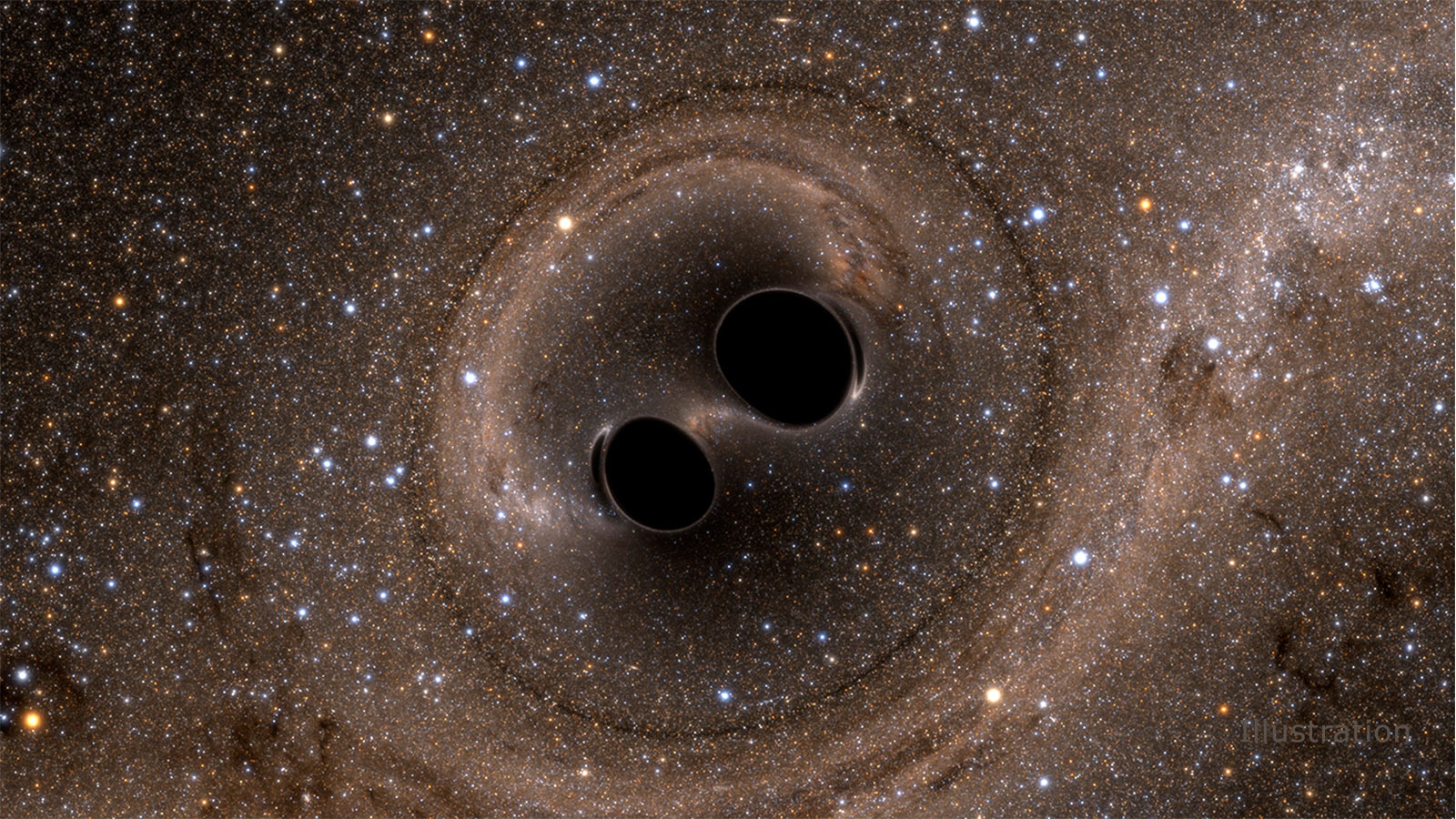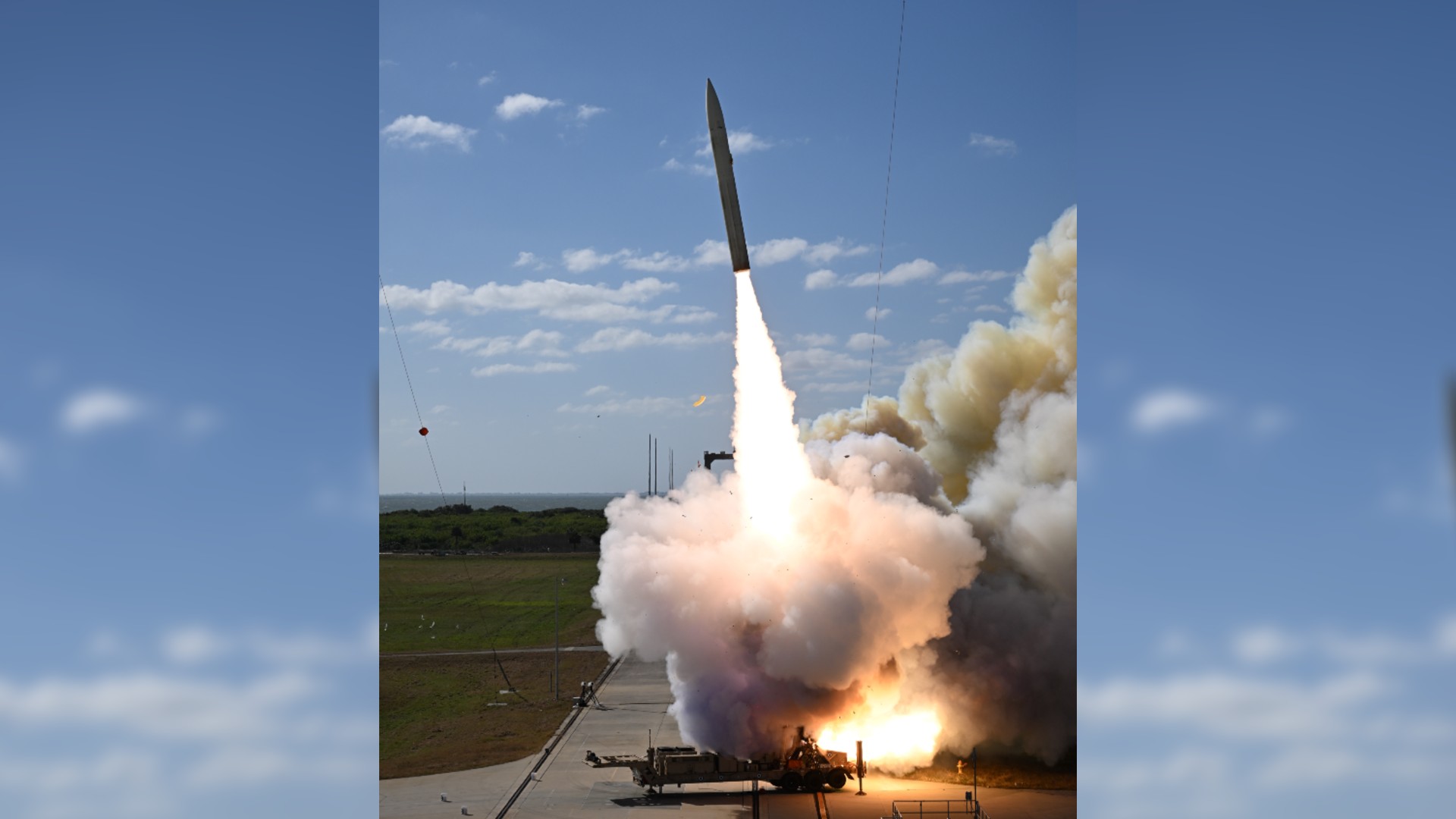
Are there any black holes left over from the Big Bang?
What would a universe flooded with primordial black holes look like?

Paul M. Sutter is an astrophysicist at SUNY Stony Brook and the Flatiron Institute, host of Ask a Spaceman and Space Radio, and author of "How to Die in Space." He contributed this article to Space.com's Expert Voices: Op-Ed & Insights.
In 2016, the LIGO (Laser Interferometer Gravitational-Wave Observatory) team surprised and delighted the world when they announced the first-ever discovery of gravitational waves, emanating from a collision of two black holes billions of years ago.
And along with the flurry of excitement (and a few Nobel prizes for good measure) came a strange little surprise. The black holes had very peculiar masses, peculiar enough that it opened up a fascinating possibility: the black holes that LIGO heard collide may have been forged when the universe was less than a second old.
Related: Black holes of the universe (images)
A guide to making black holes
We know how black holes are made in the modern-day universe. You start with a star, the bigger the better. At least eight times the mass of the sun should do the trick. Then you wait as the star burns through all its available supply of hydrogen. This should only take a few tens of millions of years. No big deal.
Then at the end of its life, the star will destroy itself in a cataclysm of energy, a supernova explosion. In the fires of that explosion, the densities in the core can reach an intense enough state that nothing — nothing at all — can resist the inward pull of gravity. So at the same time that most of the star is exploding outward, a fraction of it collapses inward on itself, folding end over end toward oblivion: a black hole.
The bigger the star, the bigger the black hole, which is what makes the LIGO results so interesting. Those colliding black holes had masses of 30 and 35 times the mass of the sun, respectively. To make a black hole that big, you either need to start out with a truly hideous monster of a star — somewhere north of 100 times the mass of the sun — or you need to build them up from mergers of lots of smaller black holes.
Get the Space.com Newsletter
Breaking space news, the latest updates on rocket launches, skywatching events and more!
At the time, both scenarios seemed unlikely. Stars that big simply don't exist in the universe (at least, nowadays), and mergers aren't common enough to build up to that.
Hence: maybe these black holes had a different origin.
Related: The universe: Big Bang to now in 10 easy steps
The Big Bang black hole machine
The early universe was, to say the least, a crazy place. Temperatures and pressures unheard of in the eons since. Phase changes that rocked the entire cosmos. Transformations that rewrote the very laws of nature.
Back then, if conditions were right, any old patch of gas may have spontaneously shrunk itself to form a black hole of any size: from something weighing just a few kilograms to thousands of times the mass of the sun, and anything in between.
For every theoretical physicist working on the problem of these so-called primordial black holes, there is at least one hypothetical mechanism for generating them, involving everything from inflation theory to colliding universes.
So in one sense, it's easy for primordial black holes to explain the early LIGO results: you just find a theory that makes black holes in the right size range and abundance, wait a few billion years, and you're bound to get a merger event.
But if you want to populate the universe with black holes from the Big Bang, they're going to do more than make LIGO sing.
Hunting in the dark
What would a universe flooded with primordial black holes look like? That's the million-dollar question, which we need to answer if we want to test this hypothesis.
For one thing, the black holes may randomly crash into other things, gravitationally attract other things, and just generally cause mayhem. Kilogram-mass black holes hitting the Earth could trigger earthquakes. A silent black hole may pull apart binary pairs of stars or disrupt entire dwarf galaxies. A black hole ramming into a neutron star could ignite a terrible explosion. Even the hypothetical Planet Nine could be a black hole no bigger than a tennis ball.
And as a bonus when it comes to potential detectability, black holes aren't entirely 100% black: they might glow, ever so faintly, through the quantum mechanical process called Hawking Radiation. Big black holes hardly glow at all: one the mass of our sun radiates around one single photon every year, taking 10^60 years to lose all its mass. But smaller black holes can go off in much less time, releasing a burst of energy in the process.
Exploding black holes may have disrupted the early universe, changing the abundance of elements or the appearance of the cosmic microwave background. Or they may be responsible for some of the gamma ray bursts that we see in our skies.
Alas, despite all our attempts, we cannot reconcile the existence of primordial black holes with the universe that we see. For every possible observational avenue, the primordial black holes cause so much mayhem that it would be noticeable to us.
In other words, as difficult as it is to explain the masses of the merging black holes that LIGO witnessed, if you want a universe with those black holes to be primordial, it would be detectable in other ways.
Learn more by listening to the episode "Did the Big Bang make black holes?" on the Ask A Spaceman podcast, available on iTunes and on the Web at http://www.askaspaceman.com. Thanks to Robert K., Peter N., and Raul P. for the questions that led to this piece! Ask your own question on Twitter using #AskASpaceman or by following Paul @PaulMattSutter and facebook.com/PaulMattSutter.
Join our Space Forums to keep talking space on the latest missions, night sky and more! And if you have a news tip, correction or comment, let us know at: community@space.com.

Paul M. Sutter is an astrophysicist at SUNY Stony Brook and the Flatiron Institute in New York City. Paul received his PhD in Physics from the University of Illinois at Urbana-Champaign in 2011, and spent three years at the Paris Institute of Astrophysics, followed by a research fellowship in Trieste, Italy, His research focuses on many diverse topics, from the emptiest regions of the universe to the earliest moments of the Big Bang to the hunt for the first stars. As an "Agent to the Stars," Paul has passionately engaged the public in science outreach for several years. He is the host of the popular "Ask a Spaceman!" podcast, author of "Your Place in the Universe" and "How to Die in Space" and he frequently appears on TV — including on The Weather Channel, for which he serves as Official Space Specialist.
-
rod This article is refreshing to read. There are not many *popular* science site reports on primordial black holes (PBH) in BB cosmology model it seems. The space.com article said "The early universe was, to say the least, a crazy place. Temperatures and pressures unheard of in the eons since. Phase changes that rocked the entire cosmos. Transformations that rewrote the very laws of nature. Back then, if conditions were right, any old patch of gas may have spontaneously shrunk itself to form a black hole of any size: from something weighing just a few kilograms to thousands of times the mass of the sun, and anything in between. For every theoretical physicist working on the problem of these so-called primordial black holes, there is at least one hypothetical mechanism for generating them, involving everything from inflation theory to colliding universes."Reply
There are newer reports out that Planet Nine could be a 5 earth mass PBH. Here is another new report on PBH.
“Primordial black holes (PBHs) can form in the early Universe through a variety of mechanisms and can account for all or part of the dark matter (DM) (e.g. ). PBHs surviving until present can span many orders of magnitude in mass, from 10^15 g to well over 10^10 Msun, and they can account for the entirety of the DM in the mass window ~ 10^−16 – 10^−10Msun, where there are no observational constraints . PBHs with sublunar masses can play a role in the synthesis of heavy elements, production of positrons, as well as other astrophysical phenomena . PBHs with larger masses can account for some of the gravitational wave events detected by LIGO as well as seed supermassive black holes . The mass window of 10 – 10^3Msun is particularly interesting in connection with signals observed by LIGO ." ref - Constraining Primordial Black Holes with Dwarf Galaxy Heating, https://ui.adsabs.harvard.edu/abs/2020arXiv200702213L/abstract, July 2020.
It seems at the present, PBH model(s) can be all over the map :) -
dfjchem721 Ever since learning about their possibility, Primordial Black Holes (PBHs) have been a pet interest. Of course every time I post about them, there are the inevitable "he-haw, what a dopey idea" responses. But with the detection of GWs and such large black holes merging, more interest has been focused on the potential formation and existence of PBHs. There now seems to be a little less he-hawing then previously encountered. Perhaps some of it has retreated to the cosmic closet.Reply
On studying the hypothetical nature of Pop. III stars that supposedly formed all the super massive BHs of the early universe, and the seeds of galaxy formation, I ran across an interesting article about PBHs. It described an alternate formation mechanism for BHs, very distinct from the "must-come-from-a-star" dogma. The process, as some of you are aware (and probably he-haw about), results in what are called "Direct Collapse Black Holes" (DCBHs). These form simply by sufficient masses of primordial hydrogen (mostly) to collapse to a BH without a stellar precursor. Of course none of these concepts rule out the formation of massive stars at the same time, which did/might undergo "standard" core-collapse.
Having zero expertise in this subject, it seemed like a prime area of study. Reports from the deepest observations reveal that the age of the earliest quasars indicate that large black holes formed much earlier than could have been made by the continuous accretion of smaller BH mergers. Due to their size and early age estimates, such objects could very well provide evidence to support PBHs that formed by a direct collapse mechanism.
A brief search for such objects turned up two that appear to be the most distant observed to date. And time-wise, they should not exist according to standard model(s) of the early universe. For instance, Quasar ULAS J1342+0928* has a mass estimated at 800 million SMs, and ca. 690 million years old. And it is not alone. Another quasar, ULAS J1120+0641** has an estimated mass of ca. 2 x 10E9 SMs***, and is ca. 770 million years old. Again, they are not supposed to be there at this early stage, or so I have read (and no retractions have been encountered).
This data on the earliest quasars could support the formation of PBHs by DCBH formation. Of course data on such objects is rather limited, probably since they are not supposed to be there, and it seems that a lot of people would rather ignore them than modify their absolute certainties about the nature of the BB and everything that came out of it. Perhaps their dogma insists on it.
One of the interesting concepts of PBHs is that they can form in almost any size, and might answer some questions about the nature of the observable universe. And they are a known object that exists in the universe (no exotic matter required). So it is with considerable interest that I find a story on these PBHs here on space.com that actually supports the concept. Do you suppose supporters of such notions will be burned at the stake?
It seems likely there are many more of these "early" quasars, they just haven't been found since the current instruments to detect them are limited, and many could be much younger, based simply on the size of the two noted above. It may simply boil down to a need for more sophisticated instruments. If they keep finding younger and younger quasars, it would seem there is a problem somewhere in some BB theories.
This is one biochemist's view on the issue, admittedly a tad outside his expertise. And do remember, that in all of science, one's concepts are only as good as the data. Any suggestions, one way or another, would be entertaining!
* https://en.wikipedia.org/wiki/ULAS_J1342%2B0928
** https://en.wikipedia.org/wiki/ULAS_J1120%2B0641
*** A luminous quasar at a redshift of z = 7.085 (Nature)
https://ui.adsabs.harvard.edu/abs/2011Natur.474..616M
Did I just hear a he-haw?! -
KC Strom So, Black Holes, primordial or otherwise, may account for a large percentage of dark mass? But, Dark Mass drives expansion? Seems counter intuitive.Reply -
dfjchem721 Not being a serious advocate of PBHs as dark matter candidates (yet), only that they cannot be ruled out. There are other things that may be better contenders. But you have an eye for reading between the lines, KC.Reply
PBHs as seeds for SMBHs at the earliest possible time for DCBH formation is another matter. That seems a more likely probability since they are seen so early in those very distant quasars, and are very large. There are earlier images of galaxies* (higher redshift) than these quasars, but the quasars are confirmed black holes, with well established mass and age. That is the biggest issue.
As I recall, dark energy may be involved in expansion. Suppose that is one too look up some time. Really like to deal with things you can see, either optically or with instruments. That is the great thing about earth-bound sciences. You get real data that does not require modelling, only proper interpretation. This is true in a green-house, or over at the Large Hadron Collider!
Perhaps some experts on dark energy, assuming such an accolade exists, might help us out on this one.
* https://en.wikipedia.org/wiki/List_of_the_most_distant_astronomical_objects -
Catastrophe I see no problem with PBHs. Everything is a matter of proportion. Some will. Some won't. Just like direct ionisation in diffused ionized gas - not in clouds, singly in gas. Last I heard it is not understood, except obviously it is by O and B stars. Any more recent suggestions would be welcome :)Reply -
5151 Sigh. Black holes are the only type of "dark matter". Black holes' gravity is the only "dark energy". Our miniverse is an infinitesimal part of the UNIVERSE. The number of black holes in the UNIVERSE > the number of stars in our miniverse. Our miniverse formed galaxies IMMEDIATELY after the "big bang" because it was orbited by millions of black holes. (See, e.g., the swarm of black holes orbiting Sagittarius *A.)Reply
Once we recognize these scientific facts, modern cosmology will take its rightful place on a dusty shelf along with Plato's and Copernicus's. And human beings will, again, be humbled by their insignificance.
OTOH, humility is the only road to truth. -
rod FYI. PBH are used in a newer model to explain Planet Nine now, perhaps a 5 earth mass PBH. This type of model can be applied to exoplanet studies too. If the early universe in the BB cosmology created an abundance of PBH, what happens to star formation theories and exoplanets? Will PBH contribute to unstable exoplanet systems? It seems all manner of PBH modeling can now be developed to show if exoplanets can be stable and suitable for life or just plain, destructive. The door is now wide open for exoplanets studies and PBH impact :)Reply








